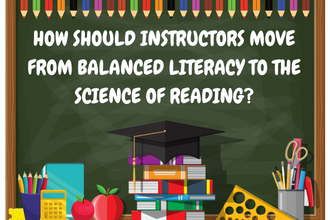How Should Instructors Move From Balanced Literacy to the Science of Reading?
Here are steps that instructors can consider when transitioning from balanced literacy to the science of reading.
1. Professional Development
Engage in professional development opportunities to deepen your understanding of the science of reading. Attend workshops, conferences, or online courses that focus on the key principles and research-based practices.
2. Stay Informed on Research
Stay updated on the latest research in the field of literacy, particularly studies that emphasize the science of reading. Reading reputable publications, journals, and research articles can help you integrate evidence-based practices into your teaching.
3. Assess Current Practices
Conduct a thorough assessment of your current literacy practices. Identify elements of the balanced literacy approach that align with the science of reading and those that may need adjustment.
4. Review Curriculum Materials
Evaluate your existing curriculum materials to determine how well they align with the principles of the science of reading. Look for resources that explicitly address phonemic awareness, phonics, vocabulary, and comprehension in a systematic and structured manner.
5. Prioritize Phonics and Phonemic Awareness
Place a strong emphasis on systematic and explicit instruction in phonics and phonemic awareness. Develop a scope and sequence that ensures a logical progression of skills, starting with basic phonetic elements and advancing to more complex patterns.
6. Incorporate Decodable Texts
Integrate decodable texts into your reading materials. Decodable books align with the phonics skills being taught, providing students with opportunities to practice decoding words within the context of the instructional sequence.
7. Provide Explicit Instruction
Ensure that your instruction is explicit, clear, and focused on the specific skills students need to become proficient readers. Clearly articulate and demonstrate the rules and patterns of the English language.
8. Assess and Monitor Progress
Implement ongoing assessment practices to monitor student progress. Use formative assessments to inform instructional decisions and provide targeted support to students based on their individual needs.
9. Adjust Literacy Centers and Activities
Modify literacy centers and activities to align with the science of reading. Include activities that target phonics skills, vocabulary development, and comprehension strategies. Design activities that support individualized instruction.
10. Collaborate with Colleagues
Collaborate with colleagues, literacy coaches, and specialists who are also transitioning to the science of reading. Share resources, discuss best practices, and collaborate on curriculum development.
11. Seek Support and Mentorship
Seek support from literacy specialists, instructional coaches, or mentors who have experience with the science of reading. Collaborate with colleagues who are knowledgeable in this area to gain insights and guidance.
Remember that the transition from balanced literacy to the science of reading is a process that may take time. It involves a commitment to ongoing professional development and a willingness to make adjustments based on research-based practices.
The goal is to create a literacy instructional approach that is systematic, explicit, and effectively supports all students in developing strong reading skills.
To find more resources to aid in the transition of your literacy program toward the Science of Reading, visit our blog page: https://www.lernerknowsliteracy.com/blog
Custom take-home packs are available. To learn more, contact a literacy specialist today.

